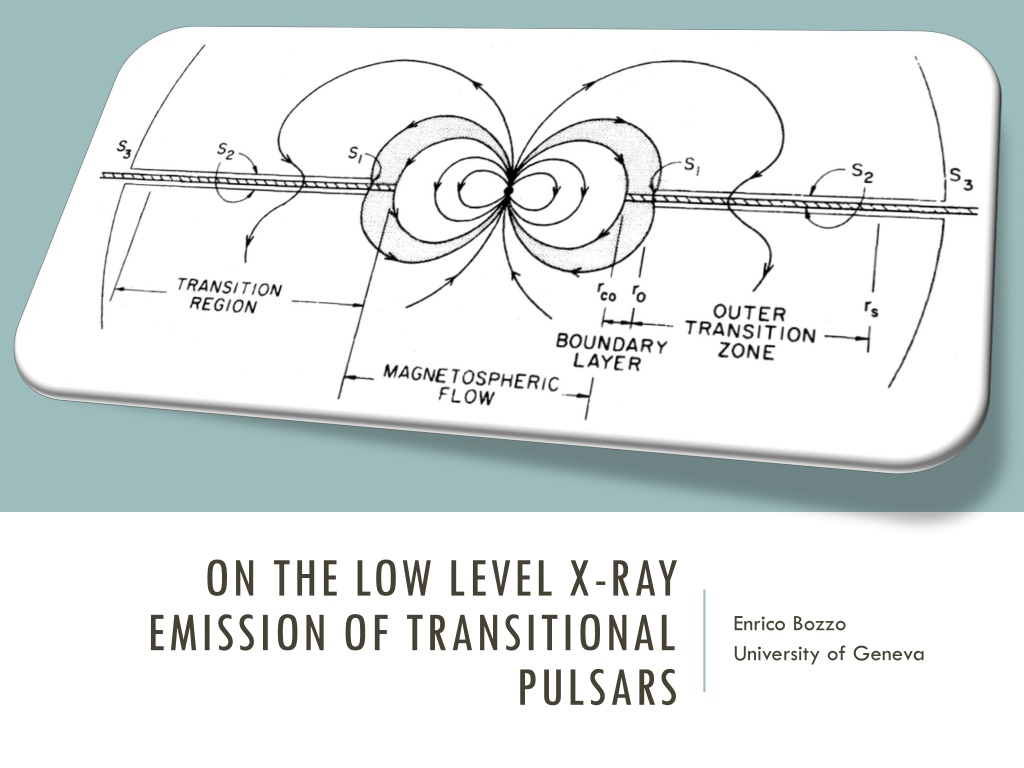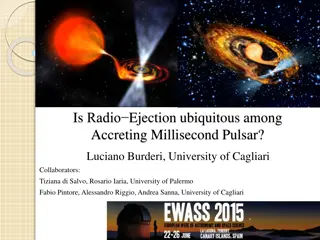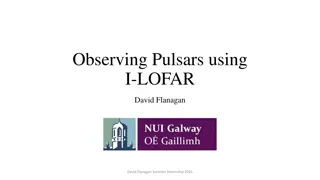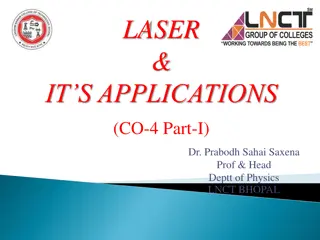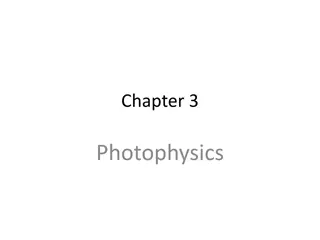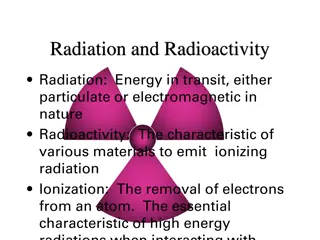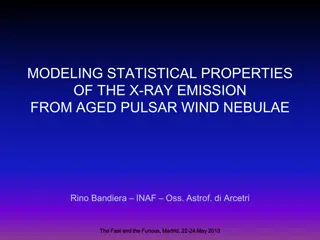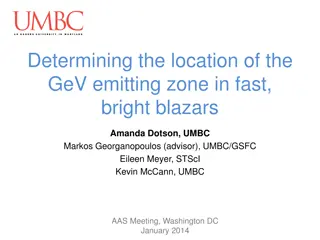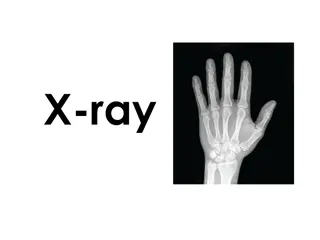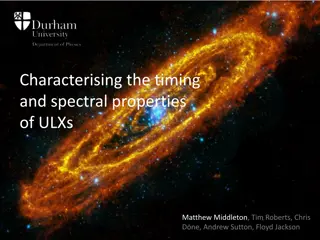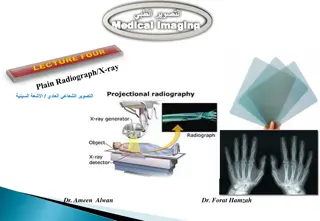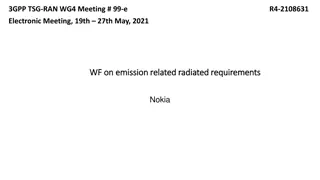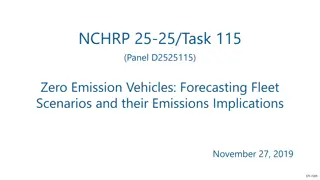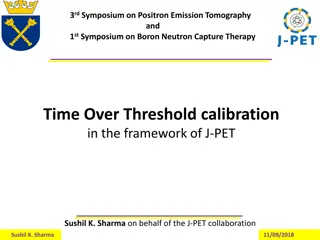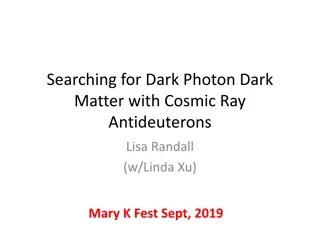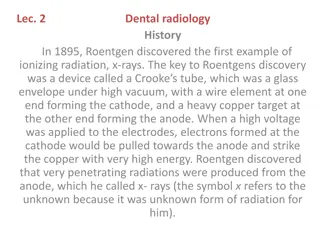Low-level X-ray Emission of Transitional Pulsars
Delve into the intriguing realm of transitional pulsars emitting low-level X-rays, exploring unique phenomena like pulsations at unprecedentedly low X-ray luminosities, the influence of accretion processes and propeller effects, and potential solutions involving outflows and the location of the magnetospheric radius. Dive deep into the complexities of these enigmatic celestial objects through cutting-edge research and simulations.
Download Presentation

Please find below an Image/Link to download the presentation.
The content on the website is provided AS IS for your information and personal use only. It may not be sold, licensed, or shared on other websites without obtaining consent from the author. Download presentation by click this link. If you encounter any issues during the download, it is possible that the publisher has removed the file from their server.
E N D
Presentation Transcript
ON THE LOW LEVEL X-RAY EMISSION OF TRANSITIONAL Enrico Bozzo University of Geneva PULSARS
TRANSITIONAL PULSARS PULSATIONS AT UNPRECEDENTEDLY LOW X-RAY LUMINOSITIES XSS 12270-4859 Pspin= 1.69 ms LX= 5x1033erg/s PSR J1023+0038 Pspin= 1.69 ms LX= 3x1033erg/s (Papitto et al. 2015) (Archibald et al. 2014)
TRANSITIONAL PULSARS PULSATIONS AT UNPRECEDENTEDLY LOW X-RAY LUMINOSITIES (Romanova et al. 2014) RM Accretion proceeds as long as the magnetospheric radius is smaller than the corotation radius In the propeller regime, the rapidly rotating neutron star generates powerful outflows K = S RM ? RM < RC Accretion RM > RC Propeller effect (ejection)
TRANSITIONAL PULSARS PULSATIONS AT UNPRECEDENTEDLY LOW X-RAY LUMINOSITIES The simplest spherical approximation
TRANSITIONAL PULSARS PULSATIONS AT UNPRECEDENTEDLY LOW X-RAY LUMINOSITIES XSS 12270-4859 Pspin= 1.69 ms LX= 5x1033erg/s (Papitto et al. 2015) Accretion only if: PSR J1023+0038 Pspin= 1.69 ms LX= 3x1033erg/s But the resulting X-ray luminosity would be orders of magnitudes above the observed one (Archibald et al. 2014)
TWO POSSIBLE SOLUTIONS: OUTFLOWS Unrealistically large outflows: About 99.8 % of the material arriving at RM shall be ejected by powerful outflows to get (Romanova et al. 2014) Radio observations support the idea of strong outflows in these systems, but from numerical simulations the strongest ejections reach ~70-80 % (Lii et al. 2014)
TWO POSSIBLE SOLUTIONS: LOCATION OF RM Beyond the spherical approximation: magnetically threaded disk models (Ghosh & Lamb 1978-9)
TWO POSSIBLE SOLUTIONS: LOCATION OF RM Beyond the spherical approximation: magnetically threaded disk models (Ghosh & Lamb 1978)
TWO POSSIBLE SOLUTIONS: LOCATION OF RM Beyond the spherical approximation: the Wang model (Wang 1981, 1987, 1995, 1997)
TWO POSSIBLE SOLUTIONS: LOCATION OF RM Comparing Wang and Ghosh & Lamb prescriptions for the magnetospheric radius (Bozzo 2009)
TWO POSSIBLE SOLUTIONS: LOCATION OF RM Comparing Wang and Ghosh & Lamb prescriptions for the magnetospheric radius (Bozzo 2009) Assuming RM~0.9 RC More reasonable outflows could allow pulsations Ejected mass: ~80-90% Closer to expected values from numerical simulations (compared to the previous 99.8%) Mass accretion rate corresponding to the X-ray luminosity of the low activity states in transitional pulsars (Bozzo et al. in prep.)
TWO POSSIBLE SOLUTIONS: LOCATION OF RM The inclined dipole case (Wang1997) is the inclination angle between the rotation and magnetic axis of the neutron star
TWO POSSIBLE SOLUTIONS: LOCATION OF RM The inclined dipole case (Wang1997) Assuming RM~0.9 RC Ejected mass: ~60-70% Mass accretion rate corresponding to the X-ray luminosity of the low activity states in transitional pulsars (Bozzo et al. in prep.)
TWO POSSIBLE SOLUTIONS: LOCATION OF RM The inclined dipole case (Wang1997) Assuming RM~0.9 RC More reasonable outflows could allow pulsations Ejected mass: ~20-30% Closer to expected values from numerical simulations (compared to the previous 99.8%) Mass accretion rate corresponding to the X-ray luminosity of the low activity states in transitional pulsars (Bozzo et al. in prep.)
TWO POSSIBLE SOLUTIONS: LOCATION OF RM The inclined dipole case (Wang1997) Assuming RM~0.9 RC Ejection not required (Bozzo et al. in prep.)
CONCLUSIONS Sometimes it is said that the magnetospheric radius within different approximations is always consistent within a factor of 2-3 In neutron star LMXBs (and transitional pulsars) that is an enormous uncertainty: RC ~ 2x106 cm (corotation radius) RCL ~ 5 x 106 cm (light cylinder radius) Different theories predict very different behaviors for the dependence of the magnetospheric radius from the mass accretion rate, especially when the propeller regime is supposed to sets in (RM RC)
CONCLUSIONS It is possible that transitional pulsars are neutron star LMXBs with a particularly high inclination angle between the spin and magnetic field axis - supported also from observations: >60 (De Martino 2014; Papitto 2014) We cannot exclude that most of the accreting millisecond X-ray pulsars display pulsations at ~1033 erg/s (but detections are hampered by the low statistics due to the larger distance). (Archibald 2014)
